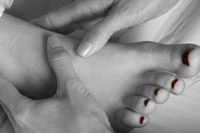The Reflexology Technique
 Reflexology
is one of the most popular and unique forms of alternative healing available
today. The term reflexology refers to the application of pressure,
movement and stretching to the feet and hands. These pressure points on
the extremities in turn effect the corresponding parts of the body. To
reflexologists, the feet and hands are a mirror of the body, and these
professionals can use their knowledge to break down patterns of stress
and pain throughout the body. Reflexology
is one of the most popular and unique forms of alternative healing available
today. The term reflexology refers to the application of pressure,
movement and stretching to the feet and hands. These pressure points on
the extremities in turn effect the corresponding parts of the body. To
reflexologists, the feet and hands are a mirror of the body, and these
professionals can use their knowledge to break down patterns of stress
and pain throughout the body.
There are many theories for how and why reflexology works, but the best approach is often to look at how the nervous system works. When pressure is applied to the feet, this pressure generates a signal which travels through the peripheral nervous system. From there, it enters the central nervous system, and it is then processed in various regions of the brain. After that, the sensation is relayed to the organs of the body, where the necessary adjustments in allocation of resources are made. After all this has occurred, a response is made and sent out to the motor system. That message is then sent forward and used to adjust overall tension level or tone of the body. When applied properly, that tone will reset to a lower level, reducing in a lessening of stress and less strain on the body’s vital immune system.
The reflexology technique is applied to the feet and hands, as every pressure point on the feet and hands is thought to correspond to some part of the body, including organ systems, limbs and torso.
The most obvious benefit of reflexology is the reduction of stress, with all its attendant benefits. Since the feet and hands set the level of tension for the entire body, reflexology uses the feet and hands to interrupt that stress level and reset it. Stress reduction is a vital part of good health, since high stress levels play a role in a number of serious diseases and chronic conditions, among them heart disease, stroke and high blood pressure.
In addition to its usefulness as a stress reliever, reflexology is also being studied as a possible way to treat and prevent other forms of illness. While the usefulness of reflexology in treating and preventing disease is still being studied, its stress relieving techniques alone provide value to any health care plan.
Reflexology is an excellent adjunct to standard medical treatment, and it should never be used as a substitute for the advice of a health care preventative. It is best to use reflexology as a complementary procedure to standard health care screenings.
While it is possible to study the charts and learn to do reflexology on oneself, most people prefer to have regular sessions with a professional reflexologist. Even for those who attend regular professional sessions, however, it is a good idea to learn to do some reflexology on their own. For instance, using this technique on oneself, say at your desk or in the office, is a great way to relieve the stress of a particularly challenging day.
The typical professional reflexology session will last from 30 minutes to one hour, and only the removal of the shoes and socks is required. Some reflexologists use a chair, while others use a table. While some practitioners use oil, most do not.
The relfexologist uses pressure, stretching and movement techniques to work through the foot in a methodical manner. The entire surface of both feet is generally worked in a single reflexology session.
The reflexologist will work within the comfort zone of the patient, as applying too much pressure could be harmful or lead to an injury. It is important for the patient to communicate with the reflexology therapist about the amount of pressure that is desired.
A quality reflexology session should leave one feeling relaxed and well. The effectiveness of a reflexology session can often be measured by how long that feeling of wellness and relaxation lasts.
|